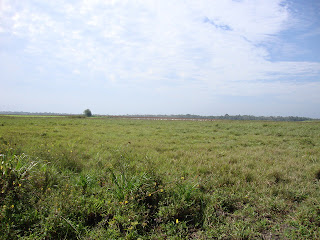 While working in the conservation field
things don't always run smoothly. There will be issues with
equipment, with the weather, but most importantly there will always
be issues with people (not to mention, if it weren't for people,
there probably wouldn't be a need for conservation in the first
place). Humans have always done their best to control or alter their
surroundings for their benefit. Unfortunately, these actions have
often been at the misfortune of the surrounding wildlife. Much work
is done to mitigate human-wildlife conflict, usually by eradicating
the “problem” and paying the victim. It is for this reason that
the project that I'm working on is so unique. We are working with
people to create a positive
attitude toward cats. The model we're following is conceptually new;
meaning we have a lot to learn.
While working in the conservation field
things don't always run smoothly. There will be issues with
equipment, with the weather, but most importantly there will always
be issues with people (not to mention, if it weren't for people,
there probably wouldn't be a need for conservation in the first
place). Humans have always done their best to control or alter their
surroundings for their benefit. Unfortunately, these actions have
often been at the misfortune of the surrounding wildlife. Much work
is done to mitigate human-wildlife conflict, usually by eradicating
the “problem” and paying the victim. It is for this reason that
the project that I'm working on is so unique. We are working with
people to create a positive
attitude toward cats. The model we're following is conceptually new;
meaning we have a lot to learn.
The
conflict that I'm witnessing firsthand, in the village of Indian
Church specifically, is that jaguars are coming into contact with
humans, livestock, or pets. Here are two recent examples:
Just
a couple days ago a local man approached Matt and I about a calf of
his that went missing. Having heard about our camera project, he was
seeking help. Matt went out to his land to see the “kill site,”
where not much was found. Once it was clear to this landowner that we
could not pay him compensation for his calf, we only pay for photos
of jaguars, the man became angry. He said he held no respect for us,
the project, the government, or conservation. He vowed to shoot the
jaguar that got his calf. And shoot a jaguar he did. There is no way
to know this was the same cat that got his calf, or that a cat even
did. Nevertheless, we received news that he shot a female jaguar, one
that had two cubs at that.
Today,
another local man was working near the jungle, and he had two dogs
with him. The dogs caught the smell of a jaguar and took off barking
after it. As the story is told, the dogs then treed the cat. The cat
retaliated, injuring one dog badly, and killing the other. As the man
approached the cat took off. We were notified, and geared up, hoping
the find the dead dog and place cameras on it. By the time we were
searching the jungle only spots of blood could be found. The cat must
have returned for the kill. Again, we fear that this man will find a
shoot a jaguar.
Indian Church is just a small piece of
the puzzle here. My theory is that there are two factors at play
increasing the probably of human-wildlife conflict concerning
jaguars. First off, the Wildcat program has been in motion since
2010. This had a positive affect on the jaguar population, as
landowners gained monetary benefit from photos of cats, causing less
hunting of the cats, therefore increasing the population over the
last few years. All the while, the Mennonite culture is gaining more
and more presence in the landscape, buying and clearing land for
monoculture farming. This destruction of habitat is forcing a healthy
population of cats into less and less habitat than before, increasing
the density of the cats, increasing the resource competition between
cats (pushing them to attack cattle that now graze on their previous
habitat), and increasing the probability of human-wildlife conflict.
This situation is disheartening, but I
can't let it get me down. Our work will continue! We finished a new
week of camera checks last week, using the ATV (the jeep is still
out, with an unknown time of return). Got some great photos,
especially one in particular of a jaguar, walking perfectly through
one of our camera stations. The lodge became a place of great energy with the
welcoming of a 45+ group of people interested in bats. Just last
night, I was introduced to Eliot Greenspan, the author of Frommer's
Travel Guide for Belize. I got the chance describe our project to him, and to personally ask him for
travel recommendations for the rest of the country, assuming that I
will one day have some time off to see other sites.

